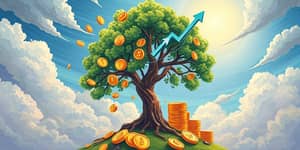
In an era dominated by viral trends and rapid-fire news cycles, many investors find themselves swept along by the latest craze. Yet without a grounded understanding of true value, these speculative waves often crash hard. This article will equip you with the knowledge to resist empty buzz and build enduring, reliable portfolios.
Investment hype thrives on spectacle and emotion. It emerges when promoters use flashy marketing or social media amplification to inflate expectations. Rather than focusing on genuine metrics, hype relies on creating a sense of urgency and fear of missing out.
At its core, hype often features questionable claims and exaggerated expectations that obscure the real state of an asset or company. By recognizing this pattern, you can pause, research, and avoid decisions driven purely by excitement.
History offers vivid lessons on the dangers of speculative frenzies. Two of the most notable include the Dutch tulip mania of the 17th century and the dot-com bubble at the turn of the millennium.
During the tulip mania, rare bulbs sold for prices equivalent to luxury homes. When reality set in, prices collapsed, leaving speculators with worthless flowers. Similarly, the dot-com era saw countless internet startups soar to astronomical valuations despite lacking clear revenue models. When the bubble burst in 2000, trillions in market value vanished.
More recently, the GameStop and meme stock saga of 2020–2021 illustrated how social media coordination can create dramatic short-term spikes—and equally dramatic reversals that left many retail investors with substantial losses.
Psychological drivers such as FOMO play a central role in hype-driven markets. When headlines trumpet meteoric gains, rational analysis often gives way to fear of being left behind. Surveys indicate that over 58% of investors admitted media and peer pressure influenced their decisions during the pandemic surge.
This emotional momentum can drown out the discipline of due diligence, leading individuals to skip fundamental checks and invest at peaks rather than in undervalued opportunities.
Spotting hype early can save you significant pain. Watch for common indicators such as:
Whenever you encounter these tactics, pause and ask whether the opportunity rests on substance or simply on sensationalism.
By contrast, fundamentals-driven strategies emphasize core attributes like revenue growth, profitability, competitive position, and management quality. These factors offer tangible evidence of long-term potential.
For example, Amazon’s soaring valuation in 2014 was underpinned by essential factors like revenue profitability growth and an unmatched market share. Unlike most hype cases, such strong fundamentals allowed Amazon to grow into its valuation rather than collapse under unrealistic expectations.
Investors committed to fundamentals typically adhere to these principles:
By prioritizing substance over hype, you position yourself to capture sustainable gains while avoiding the roller-coaster of speculative cycles.
Even themes as noble as ESG (Environmental, Social, Governance) can suffer from overpromotion. Aggressive marketing and greenwashing have led some funds to attract massive inflows despite ambiguous performance records.
Before committing capital to any ESG product, scrutinize the methodology behind its ratings. Ask whether reported sustainability metrics are backed by independent verification or simply serve promotional narratives.
To build resilience against hype-driven pitfalls, consider these actionable measures:
Implementing these practices cultivates disciplined decision-making and reduces susceptibility to fleeting trends.
In the face of sensational headlines and viral investment trends, it is tempting to chase rapid gains. However, as history repeatedly demonstrates, bubbles inflated by hype tend to burst, leaving investors nursing losses.
By centering your strategy on thorough financial research and due diligence, setting clear criteria, and maintaining a disciplined, patient outlook, you can steer clear of speculative risks and build wealth that endures.
References













